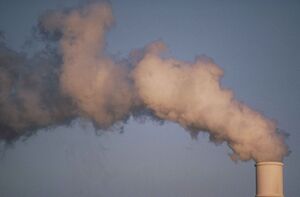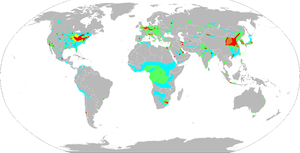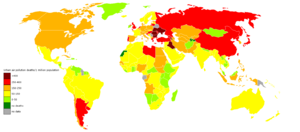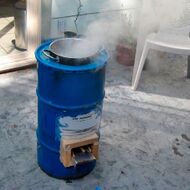
Air pollution is a chemical, particulate matter, or biological agent that modifies the natural characteristics of the atmosphere.
Worldwide air pollution is responsible for large numbers of deaths and cases of respiratory disease.[1] While major stationary sources such as power plants are often identified with air pollution, the greatest source of emissions is actually mobile sources, mainly automobiles.[2] Greenhouse gases such as carbon dioxide, which contribute to global warming, have recently gained recognition as pollutants and internationally laws are being developed to reduce these emissions.
Technologies[edit | edit source]
Particulates[edit | edit source]
Particulates are a major cause of respiratory problems - these can be reduced by:
- cleaner burning,
- Post-treatment (e.g. catalytic converters in vehicles - which require low sulfur fuel), use of air filterss
- more efficient design such that less fuel is needed:
- Less heating of buildings through passive solar design, or
- Less power, through lighter vehicles with less wind resistance, energy capturing brakes, and urban planning to reduce traffic congestion.
- Choice of fuel. Diesel is worse than standard petrol (aka gasoline) Biofuel is generally better than fossil fuel
Indoor air pollution[edit | edit source]
Indoor air pollution is a less visible threat, originating mainly in:
- offgassing from household products and construction materials containing synthetic compounds (especially in wealthy communities) and
- indoor fires for heating and cooking, including from kerosene and dung (the worst), wood (also bad) and charcoal (less harmful smoke).[verification needed]
Outdoor air pollution[edit | edit source]


Outdoor air pollution is one of the world's largest health and environmental problems – one that tends to worsen for countries as they industralize and transition from low to middle incomes.
Sources of outdoor or ambient air pollution are varied and include both natural and man-made ones. Natural outdoor air pollution includes oxides of sulphur and nitrogen from volcanoes, oceans, biological decay, lightning strikes and forest fires, VOCs and pollen from plants, grasses and trees, and particulate matter from dust storms. Natural pollution is all around us all of the time. However, sometimes concentrations can increase dramatically, for example after a volcanic eruption, or at the beginning of the growing season. Other sources include sulfur dioxide (SO2), carbon dioxide (CO2), Chlorofluorocarbons (CFCs), Smog, etc..
External links[edit | edit source]
- Wikipedia:Air pollution
- The big smoke, newstatesman.com 09 December 2002 - the smogs of London that killed thousands in the 1950s.
- Causes of air pollution,vipforair.com 24 September 2018 - The Main Causes of Air Pollution


